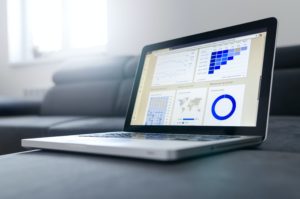|
Getting your Trinity Audio player ready...
|
By Winnie Kamau
Nairobi, Kenya: Globally newsrooms are currently going through a lot of unprecedented shakeups. The advent of new technologies has shaken many business models as survival for the fittest comes to play.
The scoops and exclusive models are slowly becoming elusive words that need to be double fact-checked. Innovation and learning new skills is what is giving us an edge in the ever-competitive newsroom.
Long gone are the days when one was comfortable being the best storyteller and the best scoops. The days of waiting till the paper goes to bed are long gone as the current technology is serving an instant thirsty generation.
A microwave generation that has no patience to wait for information. The use of one photograph is not enough; a mix of videos, podcasts, and interactive infographics is the new normal in storytelling.
Data-driven journalism is the new kid on the block who has the ability to tell complex stories with engaging visualizations like infographics so as to keep your audience glued.
Paul Bradshaw, one of the Father of Data Journalism explains this new trade-in in his Data Journalism handbook “What makes data journalism different from the rest of journalism? Perhaps it is the new possibilities that open up when you combine the traditional ‘nose for news and ability to tell a compelling story, with the sheer scale and range of digital information now available.”

“And those possibilities can come at any stage of the journalist’s process: using programming to automate the process of gathering and combining information” Paul explains.
This new skill allows a Journalist to be able to look for data, look for outliers in the data, analyze the data and be able to see a story.
In many Newsrooms around the world, Data Journalism is still at its nascent stages, and its full potential is yet to be tapped into.
In 2014, when I first did my Data-Driven Journalism class it sounded so abstract. It also required one to have a liking of mathematics and basic skills of excel. For many Journalists, mathematics is not our cup of tea except for those on the Business desk.
The ability to wrangle data in a Newsroom needs teamwork effort. In a newsroom with resources, they are able to hire a researcher, a designer, and a data analyst. This combination then makes a team where the Journalist is at the center and is able to narrate a story out of the numbers churned.
But for Freelance Journalists, Data Journalism poses a huge challenge as one is expected to encompass both the role of a researcher, analyst, designer, and storyteller but this also requires collaboration.
Speaking to Rosemary Okello Orlale the Director of Africa Media Hub at Strathmore University Business School gives a perspective of a 3thronged approach in Data Journalism that is being practiced.
“The people currently doing Data Journalisms are doing it in an ad hoc manner but we are currently doing it in partnership with Code for Africa and our approach is 3thronged in Data storytelling, Data Journalism, and Data Visualization” explains Rosemary.
Strathmore Business School is currently offering a Data Visualization unit in their Masters in Data Science. While their Data Journalism certified course is waiting for approval by the Higher Education Commission. Other courses being offered are Business Reporting and Finance Reporting using Data.
Most of the visualization tools are open source and free to use but with their own limitations. I remember there’s a product of Google that was called Fusion tables, it was a good tool for mapping and very easy to use. But suddenly Google decided to do away with the tool and those of us who had embedded the maps in our stories are now left with blank pages with no trace of the work we had done.
Another challenge of Open source tools is that the product can be free but as the organization wants to expand their services then they end up changing the algorithm which is not user-friendly and a good example is Plotly. This tool was easy to use especially for novices in Data Journalism but now it’s more technical to navigate.
The basic coding skills and being able to analyze data are skills that are needed is one that is needed in future Newsrooms.
Recently I attended a virtual course AWIM UNESCO RCCE training and it was an eye-opener. The course on Algorithms made me realize that Artificial Intelligence(AI) can ease the burden of data analysis.
The use of AI is a skill one needs to learn which is part of Machine Learning and is integral in Data telling stories. Basic Data Journalism, coding skills and Machine learning should be introduced in Schools of Journalism.
Senior Lecturer in Media Studies at Daystar University, Dr. Wambui Wamunyu urges Journalists to embrace new skills “You cannot go wrong in learning a new skill in any profession. In Journalism an understanding of the infrastructure that supports Data Journalism and Digital Journalism is important” says Dr. Wambui.
Adding “I know there’s the fear of Machines but they allow you to tell stories faster with Artificial Intelligence once you program the machine. It is happening now, machine learning can accompany Journalists” explains Dr. Wambui
A glance at the Academia landscape and how Data Journalism is being embraced in Universities is very pragmatic.
At Multimedia University (MMU)their Associate Dean Dr. Wilson Ugangu says Data Journalism is taught as an element and not as a unit “Data Journalisms is taught as an element and not a full unit with elements of Data Analysis taught as part of in-depth Investigative Journalism course” says Dr. Ugangu.
While at the Technical University of Kenya (TUK) Data Journalism has been incorporated in their curriculum “We are currently reviewing the curriculum and we are at the process of it being approved by the Commission of University Education (CUE)” explains Dr. Joy Omwoha the Academic Team Lead in the Department of Journalism Studies.
“We are currently teaching Data Journalism in another unit and our personnel is well equipped” adds Dr. Omwoha.
Not to scare Journalists but just to encourage us, the world is changing at a fast pace and has embraced technology more than ever. The Coronavirus pandemic has shown us how technology has become an integral part of our world.
If farmers are embracing technology and so are Teachers then Journalism as a profession we should not be left out.
Journalism Lecturers and Deans of Schools of Journalism are already going to the drawing board and reviewing their curriculum to incorporate the new Techniques in Technology.
An initiative introduced by a Senior Lecture Dr. Wambui won the hearts of the school and faculty which was inspired by her Doctoral thesis on The Use of Digital Technologies in Newsrooms.
“We have had workshops in partnership with Code for Africa in fact-checking and have Data Journalism presentations with small groups of students” explains Dr. Wambui.
“During one semester with our Elective Print students we did introduce Data Journalism,” said Dr. Wambui reflected on the success of Data Journalism and Digital media. This has led to the change of the Curriculum to embody Data Journalism.
Currently, due to the extemporaneous practice of Data Journalism in Kenya, there are no quantifiable data available of practitioners of this specialized field as it is a relatively new field.
But in order for our Newsrooms to survive with the ever-changing technologies in the world, then we also need to be tech-savvy in order to beat the game. No longer will the normal Journalism lectures hold the fort, a sprinkle of technology will give us an edge in storytelling in the evolving world.
Winnie Kamau is the president of Association of Freelance Journalists in Kenya.














